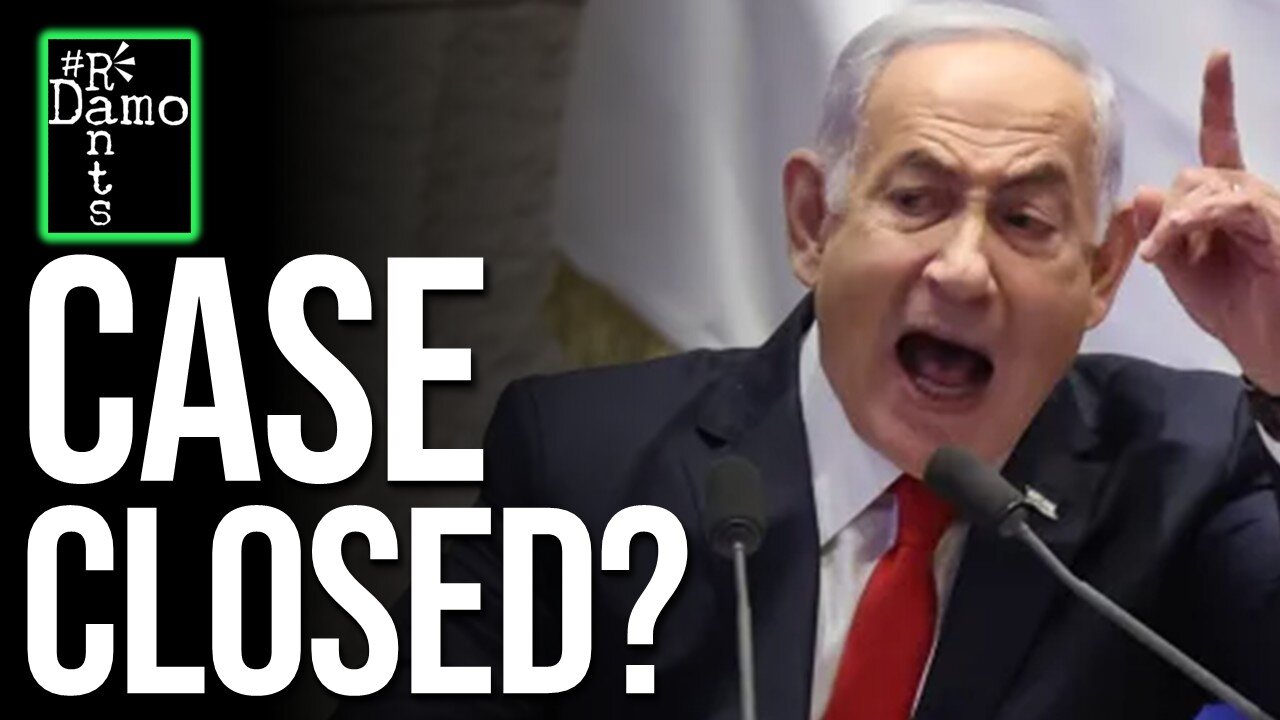Premium Only Content

Netanyahu Threatened Gaza With WWII — And Handed The ICC Its Evidence
Right, so when a prime minister facing an International Criminal Court arrest warrant decides to defend his war by citing one of the most notorious atrocities of the twentieth century, surely it becomes obvious that the mask has now irrevocably slipped. Benjamin Netanyahu’s boast that Israel “can bomb Gaza like Dresden” was not a show of strength but a Freudian slip on live television — the kind of swaggering threat that lands less like Churchillian defiance and more like a mob boss bragging about how many civilians he could wipe out if he really wanted to. The problem for Netanyahu is that Gaza is already beyond Dresden: tens of thousands dead, cities reduced to rubble, children dying of hunger. It was an insane instance on uncharacteristic honesty, even if the context was misleading. To invoke Dresden is not to warn of what Israel might do, but to confess to what it already has done — and then to threaten to do it again.
Right, so Israeli Prime Minister Benjamin Netanyahu has appeared on the American right-wing broadcaster Newsmax, a Trump favourite right now, which says it all and said “We can bomb [Gaza] like the Allies bombed Dresden.” Now, he might have intended that to sound like bravado, but it sounded instead like a chilling boast — a confession even. Dresden, the German city incinerated in February 1945, is remembered not as a triumph but as an atrocity, a firestorm that killed tens of thousands and left Europe questioning the morality of modern war. To invoke it as a model is to cite atrocity as precedent.
The irony of his comment however hasn’t been missed on anyone paying more than even cursory attention to the goings on in Gaza. Gaza is already a wasteland of rubble, its cities have been flattened, its people starving under siege. By threatening Gaza with Dresden, Netanyahu ignored the abundantly obvious fact Gaza has endured destruction beyond Dresden already. His words did not intimidate; they revealed. They revealed the mindset of a leader who treats historical atrocity as license, and they exposed Israel to even greater and deserved condemnation. Far from shielding his government, this analogy from their own leader’s mouth, has crystallised Israel’s descent into pariah status and can only have worked to accelerate Netanyahu’s own political and legal collapse, which cannot come soon enough.
The Dresden remark became emblematic of the contradictions in Israel’s war. On one hand, it sought to project strength and deterrence to both domestic audiences and sympathetic foreign media. On the other hand, it unintentionally confirmed what human-rights groups and international observers have been saying for ages: that Gaza had been subjected to devastation so sweeping and indiscriminate that it bore resemblance not to legitimate military campaigns but to the annihilation of entire cities. Netanyahu’s attempt at defiance thus operated as confession.
To understand why Netanyahu’s words resonated so appallingly and powerfully, its worth going over the historical reality of Dresden. In February 1945, the war in Europe was nearing its end. The Soviet Red Army was advancing rapidly from the east, while Western Allies pressed into western Germany. Dresden, a city of great cultural and architectural splendour on the River Elbe, had been spared the worst of the bombing campaigns that devastated cities such as Hamburg and Cologne. It was known for its opera house, its baroque skyline, and its art collections rather than for heavy industry or military command centres. Yet, over the nights of 13–15 February, waves of British and American bombers descended upon it.
Historical records indicate that Allied bombers dropped approximately 3,100 tons of high-explosive and incendiary bombs on Dresden: around 2,700 tons by the RAF and another 400 tons by the U.S. Eighth Air Force.
The resulting firestorm was catastrophic: dozens of small fires converged into a raging inferno that sucked oxygen away from shelters, causing many victims to suffocate or burn.
Contemporary eyewitness accounts describe a scene of apocalyptic destruction: streets ablaze, buildings collapsing, and survivors incinerated amid searing heat—though precise temperature figures remain unverified. The death toll remains debated too. Nazi propaganda spoke of hundreds of thousands, but scholarly studies based on forensic records and postwar inquiries estimate around 25,000 fatalities. What cannot be disputed is the scale of cultural and physical destruction. Dresden’s Frauenkirche collapsed into rubble. The Zwinger Palace was gutted. Tens of thousands of homes were obliterated, and hundreds of thousands displaced.
What made Dresden especially controversial was its timing and strategic ambiguity. By February 1945, Germany was effectively beaten. The Nazi regime remained vicious and dangerous, but its defeat was inevitable. Dresden was not a hub of armaments production. It did have rail junctions and some military-relevant facilities, but nothing that clearly justified the annihilation of the entire city. Critics argued the bombing was an act of terror designed to shatter morale and impress the Soviets with Western firepower. Even Winston Churchill, whose government had endorsed area bombing, later questioned it, writing that such attacks seemed like “mere acts of terror and wanton destruction.”
Dresden thus entered history not as a military victory but as a cautionary tale. Alongside the likes of Hiroshima, Nagasaki, and Tokyo, it symbolised the horrifying potential of modern warfare to obliterate entire civilian populations.
The moral unease with Dresden fed directly into the postwar development of international humanitarian law. The Nuremberg and Tokyo Tribunals prosecuted many crimes, but largely sidestepped the question of Allied bombing. Yet legal scholars and diplomats recognised that such destruction could not be left unaddressed. The Geneva Conventions of 1949 extended protections to civilians, prisoners of war, and the wounded.
Most crucial were the 1977 Additional Protocols, drafted after decades of reflection on the Second World War’s horrors. Protocol I, Article 51, outlawed indiscriminate attacks. It explicitly forbade treating entire cities or towns as single military objectives. Article 52 enshrined protections for civilian objects, prohibiting their attack unless they directly contributed to military action. Article 57 imposed obligations of proportionality and precaution: commanders must weigh military advantage against civilian harm and take steps to minimise the latter. Starvation was banned as a weapon of war.
The International Committee of the Red Cross (ICRC) later codified these principles as customary international humanitarian law. The core rule was unmistakable: area bombardments against populated cities are illegal. If Dresden could be rationalised in 1945, it could not be justified today.
So when Netanyahu goes ahead and evokes Dresden in 2025, therefore, he did not just choose a vivid historical metaphor. He cited a case study that international law has deliberately defined as beyond the pale. In doing so, he strengthened the perception that Israel regards itself as above the law.
The statistics from Gaza underscore why Netanyahu’s analogy has been received as so damning. As of this month, more than 62,000 Palestinians have been killed since the outbreak of Israel’s campaign in October 2023, according to UN-cited official figures and of course we know the actual death toll will be considerably higher, given 10% of Gaza’s 2 million strong population can no longer be accounted for. This is more than double the casualties of Dresden, inflicted not in a few nights but across nearly two years of bombardment.
Satellite analyses by UNOSAT confirm that between 60 and 70 percent of Gaza’s housing stock has been damaged or destroyed. Entire neighbourhoods of Gaza City, Khan Younis, and Rafah lie in ruins. Hospitals, schools, mosques, and UN facilities have been repeatedly struck. Where Dresden lost its historic centre, Gaza has lost virtually every urban district.
The tonnage of ordnance dropped further highlights the disparity. Whereas Dresden was hit with 3,900 tons, rights groups estimate more than 70,000 tons have fallen on Gaza since October 2023. This makes Gaza one of the most bombed territories in modern history, surpassing not only Dresden but also the WWII bombings of London and Hamburg combined.
Unlike Dresden, Gaza is subject to siege. Israel has cut electricity, fuel, and most imports, throttled humanitarian aid, and systematically obstructed convoys. The result is famine conditions. The UN confirmed that at least 98 children had died of malnutrition by this month, with thousands more at risk. Starvation, prohibited under Protocol I, is here not a possibility but an unfolding atrocity.
Thus when Netanyahu threatens Gaza with a Dresden-style onslaught, it shouldn’t surprise people that so many are asking: what is left to destroy? Gaza is already flattened. Its residents live in tents or among ruins. The only thing left to bomb is the displaced population itself.
Historians were equally damning. Scholars of the Second World War stressed that Dresden is remembered precisely because it represents what not to do. To hold it up as precedent is to invert history’s lessons. But this framing, historians argued, is historically inaccurate and morally reckless. Gaza is not Nazi Germany; it is an occupied enclave of civilians and that is true no matter how many Zionists compare the captive population to the Nazis, which they do incessantly and yet somehow still manage to look at themselves in the mirror.
Even allies struggled with this one. US Ambassador Mike Huckabee attempted to defend Netanyahu, because of course he would, Christian Evangelism goes hand in hand with Zionism, mocking British Prime Minister Keir Starmer for actually opposing Israel’s plans for total conquest of Gaza, I know, don’t faint, and he repeated the Dresden analogy himself. Yet the effect was the opposite: rather than legitimise Israel’s conduct, it highlighted the grotesque willingness of Israel’s defenders to normalise absolute atrocity.
The remark came as Israel’s international standing is collapsing. Germany has halted arms exports usable in Gaza and Norway’s $2 trillion sovereign wealth fund has divested from 11 Israeli firms with a further 50 under consideration. Canada, the UK, and France moved toward recognising a Palestinian state. Israeli cruise liners faced protests in Greece. Across Europe, dockworkers have been blocking shipments of arms to Israel, all stories this channel has covered in recent weeks of course.
At the legal level of course, the International Criminal Court has issued those arrest warrants for Netanyahu and Former Defence Minister Yoav Gallant, citing war crimes including starvation of civilians. More arrest warrants are now in thee works apparently against Bezalel Smotrich and Itamar Ben-Gvir. Netanyahu’s public invocation of Dresden strengthened perceptions of intent, providing prosecutors with rhetorical ammunition. Rather than defending himself, he had in effect supplied evidence against himself.
The cumulative effect is Israel’s transformation from embattled democracy to pariah state. Allies once cautious about criticism now find themselves compelled to distance. For Netanyahu personally, the Dresden analogy will likely be remembered as the moment he confirmed his own legal vulnerability.
Inside Israel, the picture is equally bleak for Netanyahu. Polling shows that 70 percent of Israelis no longer trust his government, including almost half of coalition supporters. Protests and strikes have spread across cities, with demonstrators demanding a ceasefire and the release of hostages. Significantly, 69 percent of Israelis say they would accept ending the war in exchange for the hostages’ return — a stance at odds with Netanyahu’s pledge of “total victory.”
Internationally, his reputation has nosedived. A Gallup poll reported by Newsweek found that 52 percent of Americans view him unfavourably, with only 29 percent favourable — his worst ever rating. Approval for Israel’s campaign has dropped to 32 percent, with only 10 percent of young Americans supportive. Among Democrats, sympathy for Israel has nearly evaporated. The once ironclad bipartisan consensus is fractured, leaving Netanyahu dependent on US Republican elites while losing the wider American public.
Thus the Dresden remark functions not only as an international gaffe but as a domestic liability. It crystallises a broader sense that Netanyahu is out of touch, genocidal, reckless, and isolated.
The question remains though: why on Earth would Netanyahu invoke Dresden at all? The answer lies in audience. On Newsmax, addressing American conservatives, the analogy may have seemed resonant. For some US viewers, Dresden symbolises overwhelming Allied might, the crushing of Nazism, and the justice of total war. Netanyahu may have hoped to align Israel with that narrative.
Yet globally, Dresden is not remembered as triumph but as atrocity. The analogy therefore backfired. Historically, it misrepresents the reality: Dresden was late-war terror bombing, Gaza is a civilian enclave under occupation. Legally, it incriminates: Dresden-style bombardment is prohibited today. Morally, it collapses: citing atrocity as precedent reveals contempt for civilian life. Politically, it isolates: it pushes allies away and accelerates popular opposition.
The result is that Netanyahu’s attempt at bravado has accelerated the erosion of Israel’s legitimacy and his own political credibility.
The Dresden analogy raises wider and more troubling questions on top of that though. What does it reveal about a leader’s mindset when he invokes a historical atrocity as precedent rather than warning? Does it signal that Israel has abandoned any pretence of proportionality? Does it reflect a broader erosion of global norms, whereby states feel emboldened to flout humanitarian law without consequence?
It also raises questions of memory. The Holocaust was long invoked by Israel as a moral shield. Now, by citing Dresden, Netanyahu appears to weaponise atrocity as license. It inverts the very purpose of historical remembrance. Rather than “never again,” it becomes “again is fine, as long as it serves us.” This appropriation of memory degrades both history and morality.
Finally, there is the question of Gaza’s place in future memory. Will Gaza become, like Dresden, Guernica, or Hiroshima, a symbol of atrocity that transcends its immediate context? Will the rubble of Gaza stand as the twenty-first century’s icon of urban annihilation? If so, Netanyahu’s analogy may prove prophetic in a way he never intended: not by defending Israel, but by ensuring Gaza becomes the new Dresden in global consciousness.
Benjamin Netanyahu’s invocation of Dresden was not just reckless rhetoric — it was an inadvertent confession. He wanted to show strength, but instead he admitted to atrocity. He warned Gaza of a firestorm that had already consumed it. He cited a massacre remembered as unforgivable, and in doing so, he aligned himself with it.
The consequences of this are bluntly stark. Gaza today stands beyond Dresden: more dead, more destruction, famine added to bombardment. International law was written precisely to prevent “another Dresden,” yet Netanyahu flaunted it as an option. The result has been Israel’s deepening isolation, his own legal jeopardy before the International Criminal Court, collapsing trust at home, and dwindling support abroad.
The cause and effect are brutally clear. By threatening Gaza with Dresden, Netanyahu confirmed Gaza is already Dresden — and worse — and in the process he must surely have sealed his own political and moral downfall. History will not remember his boast as a sign of strength but as a moment of exposure, when a leader spoke aloud the atrocity he was already committing.
More arrest warrants being issued for Israeli ministers simply backs this picture up, but the drawing up of ICC warrants against Smotrich and Ben-Gvir are historical firsts, because nobody has ever been prosecuted for the crime of apartheid before, intent is a pesky thing to prove. Fortunately, just like Netanyahu, both have said the quiet part out loud in just the last week, which should by rights make the prosecutors job a formality now. Get all the details of that story in this video recommendation here as your suggested next watch.
Please do also hit like, share and subscribe if you haven’t done so already so as to ensure you don’t miss out on all new daily content as well as spreading the word and helping to support the channel at the same time which is very much appreciated, holding power to account for ordinary working class people and I will hopefully catch you on the next vid. Cheers folks.
-
 20:46
20:46
Jasmin Laine
1 day agoJoe Rogan Drops NUKE—Carney’s Secret Deal + 100,000 Kamloops Homes at Risk
13.1K31 -
 4:00
4:00
Mrgunsngear
1 day ago $20.01 earnedFirst They Came For Glock, Now They're Coming For The Ruger RXM
27.9K18 -
 1:42:46
1:42:46
Lara Logan
1 day agoINJECTING TRUTH INTO THE VACCINE DEBATE with Del Bigtree | Ep 43 | Going Rogue with Lara Logan
20.7K34 -
 12:55
12:55
Cash Jordan
21 hours agoNYC Busses 'MOBBED' by Millionaires... as "Communist" Mayor VOWS to END AMERICA
17.5K36 -
 18:54
18:54
Bearing
1 day agoNew York COMMUNIST TAKEOVER 🚨 Zoran Mamdani’s Revolution 💥
19K94 -
 1:05:26
1:05:26
Man in America
1 day ago“Poseidon” Doomsday Sub, Microplastics & The War on Testosterone w/ Kim Bright
50.6K55 -
 12:15
12:15
Degenerate Jay
23 hours ago $0.49 earnedIs GTA 6 In Trouble?
6.61K -
 6:40:54
6:40:54
FyrBorne
16 hours ago🔴Battlefield 6 Live M&K Gameplay: Who's Hunting Who?
49.4K -
 LIVE
LIVE
Times Now World
5 days agoVladimir Putin LIVE | Putin rushes to help Maduro, sends Wagner Group | US-Venezuela News | Trump
54 watching -
 LIVE
LIVE
DynastyXL
7 hours ago🔴LIVE Slurp Man when? Lets PLAY with viewers
52 watching